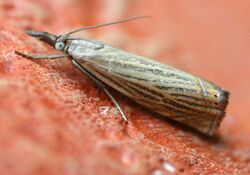Biology:Chrysoteuchia culmella
From HandWiki
Short description: Species of moth
| Chrysoteuchia culmella | |
|---|---|

| |
| Scientific classification | |
| Kingdom: | |
| Phylum: | |
| Class: | |
| Order: | |
| Family: | |
| Genus: | |
| Species: | C. culmella
|
| Binomial name | |
| Chrysoteuchia culmella (Linnaeus, 1758)
| |
| Synonyms | |
| |
Chrysoteuchia culmella, the garden grass-veneer, is a species of moth of the family Crambidae. It was first described by Carl Linnaeus in his 1758 10th edition of Systema Naturae. It is found in Europe.
The wingspan is 18–24 mm. The forewings are brown ; a whitish median streak, ending in branches along veins 2-5, often separated by dark fuscous scales ; dorsal 2/3 often wholly suffused with whitish-ochreous ; a terminal series of black dots ; cilia metallic. Hindwings are rather dark grey. The larva is pale pinkish-ochreous ; spots brown ; head and plate of 2 brown, darker- marked.[1]
The moth flies from June to July depending on the location.
The larvae feed on various grasses.
References
- ↑ Meyrick, E., 1895 A Handbook of British Lepidoptera MacMillan, London pdf
 This article incorporates text from this source, which is in the public domain. Keys and description
This article incorporates text from this source, which is in the public domain. Keys and description
External links
- Chrysoteuchia culmella. UKMoths.
Wikidata ☰ Q1358997 entry
 |


